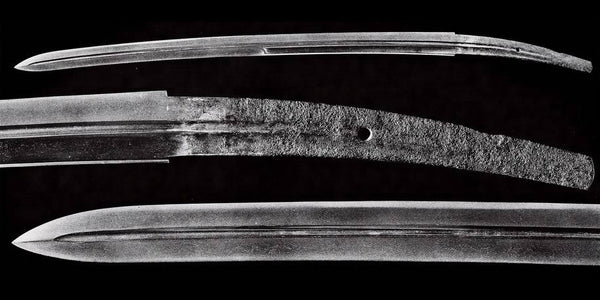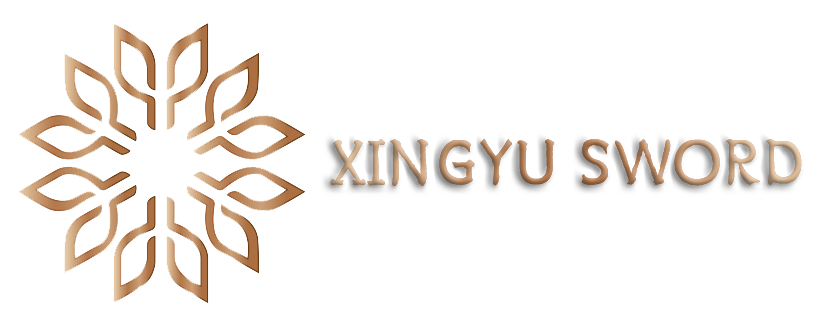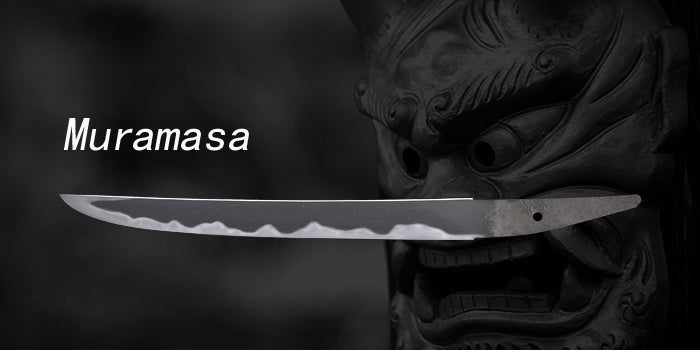Double edge Katana-Kissaki-Moroha-Zukuri

The kissaki-moroha-zukuri is known as the father of the Japanese sword. It has the shape of a sori, which is common in Japanese swords, but has a double-sided blade, which means that it has the characteristics of a curved sword and a double-edged blade at the same time, and this peculiar shape is also known as "kogarasu-zukuri," which is a transitional style from a straight sword to a curved sword. This peculiar shape is called "kogarasu-zukuri" and is the transition from the straight sword to the curved sword. The reason for this peculiar design begins with the first Shogun of Japan, Sakagami Tamura-Maru.
When Emperor Hengmu moved his capital to Heian-kyo at the end of the eighth century, he twice dispatched armies to crush the insubordinate shrimp barbarians in the northeast. At this time, Ezo referred to the aborigines of the Tohoku region, which later became synonymous with the aborigines of Hokkaido. The Ezo were skilled in horsemanship and used わらびてとう to fight, and defeated the armies sent by the imperial court. The hilt of the わらびてとう is curved and resembles a fern, hence the name. The imperial soldiers used straight swords with straight hilts, which were better suited to stabbing than slashing, and were often cut off by the wara-bitetsu when they fought against each other. Because the わらびてとう could be unsheathed more quickly, and because its slightly curved shape dispersed the impact of the sword's blows, it was always able to gain the upper hand in critical moments.
After the soldiers were defeated in their first battle, the Emperor ordered Sakagami Tamura Mamoru to become the Shogun of the Bewildered Ebisu, and once again to send out an army to crush the Ebisu. In order to overcome the shortcomings of the straight sword, Sakagami Tamura Maro ordered the sword maker to thicken the blade of the straight sword, and achieved a strategic victory by weakening the swords of the Ezo army through steady tactics.
Legend has it that after Sakagami Tamamaro's victory over the Ezo army, a divine bird suddenly flew into Heianji Temple, claiming to be a messenger sent by Amaterasu Omikami, and left behind a precious sword before disappearing without a trace. Emperor Hengmu thought it was a gift from Amaterasu Omikami and named the sword kogarasu-zukuri.
Of course, the kamaboko had no way of forging a Japanese sword, and it is rumored that the person who forged the kogarasu-zukuri was the swordsmith Tenkoku of the Yamato country, and it is reputed to be the originator of the Yamato-den in Gokaden. Before Emperor Hengmu moved the capital to Heian-kyo, most of the capital was located in Yamato, and the local swordsmiths who served the court and Buddhist temples. kogarasu-zukuri combines the characteristics of both the double-edged swords of the continental culture, as well as the wara-bi-te-tou, which came from the Ezo people, and has the shape of a transitional period in which the straight sword evolved into a curved sword. The sword's hada is a small itame hada with a slightly irregular mountain pattern, and the hamon is mainly suguha.
However, according to the evidence, the surviving kogarasu-zukuri should be a sword forged in the middle of the Heian period, not the early Heian period as the legend has it. After the war, Sakagami Tamura Mamoru introduced the わらびてとう used by the Ezo people to Heian Jing=kyo, and placed Ezo prisoners who were good at forging わらびてとう in Kanto and Heian Jingo, and the Japanese soldiers who had suffered from the わらびてとう also improved their swords into けぬきがたたち, also known as the captive tachi, which has a sori. kogarasu-zukuri is supposed to have been made in the けぬきがたち The kogarasu-zukuri is supposed to be a unique sword with a more aristocratic flavor created by sword makers under the trend of けぬきがたたたち.
When Emperor Hengmu moved his capital to Heian-kyo at the end of the eighth century, he twice dispatched armies to crush the insubordinate shrimp barbarians in the northeast. At this time, Ezo referred to the aborigines of the Tohoku region, which later became synonymous with the aborigines of Hokkaido. The Ezo were skilled in horsemanship and used わらびてとう to fight, and defeated the armies sent by the imperial court. The hilt of the わらびてとう is curved and resembles a fern, hence the name. The imperial soldiers used straight swords with straight hilts, which were better suited to stabbing than slashing, and were often cut off by the wara-bitetsu when they fought against each other. Because the わらびてとう could be unsheathed more quickly, and because its slightly curved shape dispersed the impact of the sword's blows, it was always able to gain the upper hand in critical moments.
After the soldiers were defeated in their first battle, the Emperor ordered Sakagami Tamura Mamoru to become the Shogun of the Bewildered Ebisu, and once again to send out an army to crush the Ebisu. In order to overcome the shortcomings of the straight sword, Sakagami Tamura Maro ordered the sword maker to thicken the blade of the straight sword, and achieved a strategic victory by weakening the swords of the Ezo army through steady tactics.
Legend has it that after Sakagami Tamamaro's victory over the Ezo army, a divine bird suddenly flew into Heianji Temple, claiming to be a messenger sent by Amaterasu Omikami, and left behind a precious sword before disappearing without a trace. Emperor Hengmu thought it was a gift from Amaterasu Omikami and named the sword kogarasu-zukuri.
Of course, the kamaboko had no way of forging a Japanese sword, and it is rumored that the person who forged the kogarasu-zukuri was the swordsmith Tenkoku of the Yamato country, and it is reputed to be the originator of the Yamato-den in Gokaden. Before Emperor Hengmu moved the capital to Heian-kyo, most of the capital was located in Yamato, and the local swordsmiths who served the court and Buddhist temples. kogarasu-zukuri combines the characteristics of both the double-edged swords of the continental culture, as well as the wara-bi-te-tou, which came from the Ezo people, and has the shape of a transitional period in which the straight sword evolved into a curved sword. The sword's hada is a small itame hada with a slightly irregular mountain pattern, and the hamon is mainly suguha.
However, according to the evidence, the surviving kogarasu-zukuri should be a sword forged in the middle of the Heian period, not the early Heian period as the legend has it. After the war, Sakagami Tamura Mamoru introduced the わらびてとう used by the Ezo people to Heian Jing=kyo, and placed Ezo prisoners who were good at forging わらびてとう in Kanto and Heian Jingo, and the Japanese soldiers who had suffered from the わらびてとう also improved their swords into けぬきがたたち, also known as the captive tachi, which has a sori. kogarasu-zukuri is supposed to have been made in the けぬきがたち The kogarasu-zukuri is supposed to be a unique sword with a more aristocratic flavor created by sword makers under the trend of けぬきがたたたち.


Leave a comment
This site is protected by hCaptcha and the hCaptcha Privacy Policy and Terms of Service apply.